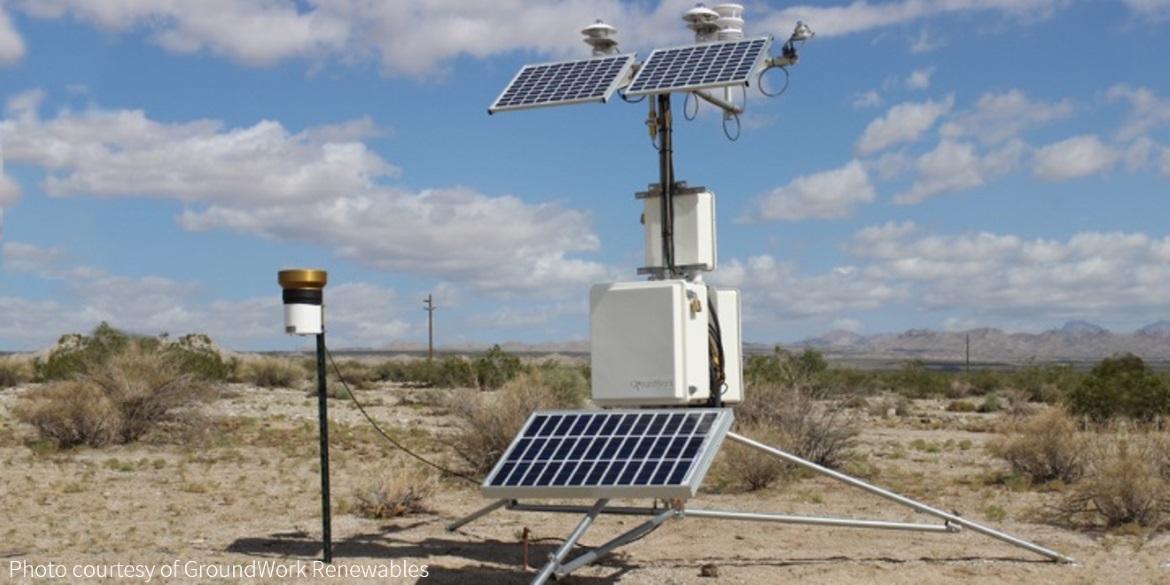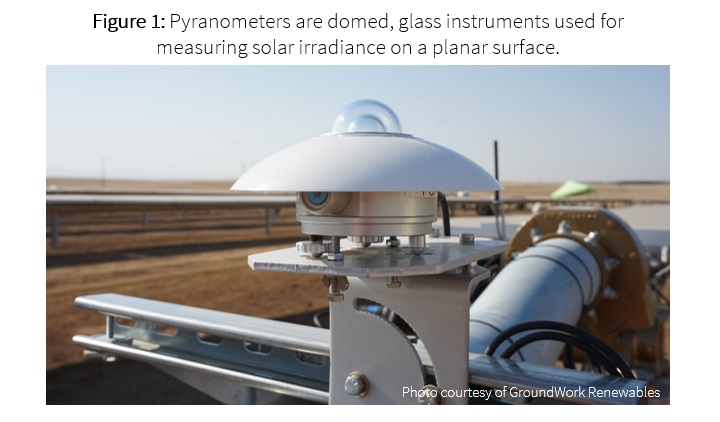This week, we’re pleased to present a post from GroundWork® Renewables’ CEO Ann Gaglioti.
Measuring irradiance data in the field reduces the uncertainty of the energy production assessment and results in a measurable return on investment during project financing. In eight years of serving the solar development community, GroundWork® Renewables‘ observational MET program combines high quality equipment and its rigorous data quality program, GroundWatch® to achieve a field uncertainty as close to the instrument uncertainty as possible.
Observational MET program
Timing and siting
Solar developers typically deploy MET equipment when the project AC capacity is 10MW or higher and land acquisition is complete. Ground campaigns are run for a minimum of 1 year. Collaboration with developers and landowners to properly site the MET station is key. Many factors are considered to ensure data quality, allow access for proper maintenance and maintain security of the station. The MET station should be mobile, fenced, and log data for transmission back to servers.
High quality equipment
Irradiance is king
PV developers require global horizontal irradiance (GHI) data to characterize solar resource and model energy production. GHI is the total solar radiation incident upon a surface when mounted horizontal to the earth. Groundwork measures GHI with redundant secondary-standard pyranometers, either the Hukseflux SR20 or Kipp & Zonen CMP11. These instruments provide a best case measurement uncertainty of 2%. With redundant measurements and reliable maintenance, GroundWork strives to achieve a field uncertainty as close to the instrument uncertainty as possible.
Diffuse horizontal irradiance (DHI) data further aids energy modelers in determining the energy available at the plane of the array. This is particularly useful for single-axis tracking arrays. DHI is all the available light that has been scattered by the atmosphere. For DHI, GroundWork deploys either the Irradiance RSR2, DeltaT SPN1 or EKO SunTracker with a shaded secondary-standard pyranometer along with a pyrheliometer measuring DNI. The selection of DHI measurement equipment is always cost versus uncertainty. The RSR2 and SPN1 instrument uncertainty is around 5-15%, while the tracked solution provides a best case GHI, DHI and DNI measurement uncertainty of 1.5%.
Ancillary MET measurements
MET systems should measure relative humidity, temperature, wind speed, wind direction, barometric pressure and precipitation. MET data is often required by the utility contracted to purchase power. It is used in the power modeling process and to inform array design.
Soiling measurement
It is cost effective to measure site-specific soiling trends in conjunction with the MET campaign. We utilize the same data logging and data transmission infrastructure but also leverage the same maintenance technician. GroundWork deploys two, small solar panels. One is left soiled while the other is cleaned weekly. This resulting data can inform the soiling rate assumption when modeling energy output.
GroundWatch®
Onsite maintenance
Pyranometers are domed, glass instruments and can get fouled, resulting in lower irradiance readings and increased uncertainty. Technicians visit weekly to clean & level the irradiance sensors, inspect the ancillary MET sensors and verify the security of the equipment. The resulting metadata accompanies the dataset through the financing process to affirm the field uncertainty.
Data quality assurance
With a dataset that is so valuable, it is paramount to ensure its safe transmission, storage and analysis. Our data-quality algorithms and visual analysis alert our team and flag data that looks suspect. We quickly recognize, diagnose and rectify any anomalies in the data to minimize ‘holes’ in the dataset. We can then deploy our maintenance technicians to check on the equipment and return it to good working order.
Ensuring certainty – A good investment
A quality ground data measurement campaign can be performed for a nominal cost relative to the total CapEx (capital expenditure) of a utility-scale solar project. The results can reduce the uncertainty of the energy production assessment resulting in lower financing costs and more accurate production estimates. At GroundWork, we are passionate about our small part to help fuel the solar industry’s growth and will continue to evolve our offerings to meet the industry’s needs.
About our guest author

Photo: Michael Troutman/www.dmtimaging.com
Ann Gaglioti is founder and CEO of GroundWork Renewables. GroundWork® Renewables is in its eighth year, building, deploying and maintaining equipment to measure on-site irradiance and ancillary data for project development and operational solar installations. Through the partnership with Clean Power Research, GroundWork provides industry-leading ground tuned resource assessment. Using data from its comprehensive observational MET program, which includes high quality equipment and the rigor of the GroundWatch® data quality program, in conjunction with SolarAnywhere®, GroundWork is able to produce a long-term bankable solar irradiance dataset that reduces risk on solar project finance. We’ll be talking more about this partnership at Solar Power International, September 12 – 16th. Stop by our booth (Clean Power Research #608 or GroundWork #612) to learn more!

